Does bisexuality exist?
yes
Zoomers are about 7 to 15 times more likely to identify as bisexual in comparison to Xers or boomers:
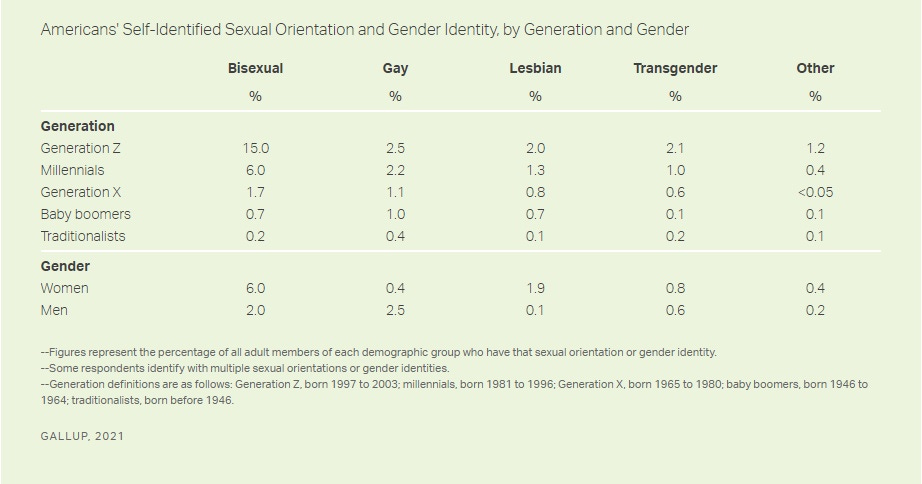
Caplan argues this rise is caused by socialization and does not changes in arousal:
What’s really going on? The best stories are the very mechanisms that Wikipedia dismisses: recruitment and the media.
Let’s start with “recruitment.” On reflection, this is just a slightly conspiratorial synonym for socializing. When the Mormons next door invite you to come to their church, you could call it “recruitment,” “outreach,” or “just being neighborly.” Tomato, tomahto. Whatever you call it, this is a good way to make more Mormons.
Similarly, the more openly LGBT people you socialize with, the more likely you are to consider giving their lifestyle a try - especially if the costs of trying are low. When stigma falls, this doesn’t merely lead confirmed LGBTs to come out of the closet; it also means that lots of straight-by-default people start socializing with LGBTs. Which is a good way to make more LGBTs.
84% of bisexuals are in straight relationships and people tend to fluctuate quite a bit between identifying as straight/bi and gay/bi. Stereotypically, bisexuals are gays who are too afraid to come out as gay or are just pretending. This could lead one to believe that bisexuality as a sexual orientation does not exist.
Which is not the case, for men or for women.
Male bisexuality
Consider the relationship between self-reported sexuality on the kinsey scale and genital arousal (male - female):
Rieger, G., Chivers, M. L., & Bailey, J. M. (2005). Sexual Arousal Patterns of Bisexual Men. Psychological Science, 16(8), 579–584. doi:10.1111/j.1467-9280.2005.01578.x
There has long been controversy about whether bisexual men are substantially sexually aroused by both sexes. We investigated genital and self-reported sexual arousal to male and female sexual stimuli in 30 heterosexual, 33 bisexual, and 38 homosexual men. In general, bisexual men did not have strong genital arousal to both male and female sexual stimuli. Rather, most bisexual men appeared homosexual with respect to genital arousal, although some appeared heterosexual. In contrast, their subjective sexual arousal did conform to a bisexual pattern. Male bisexuality appears primarily to represent a style of interpreting or reporting sexual arousal rather than a distinct pattern of genital sexual arousal.
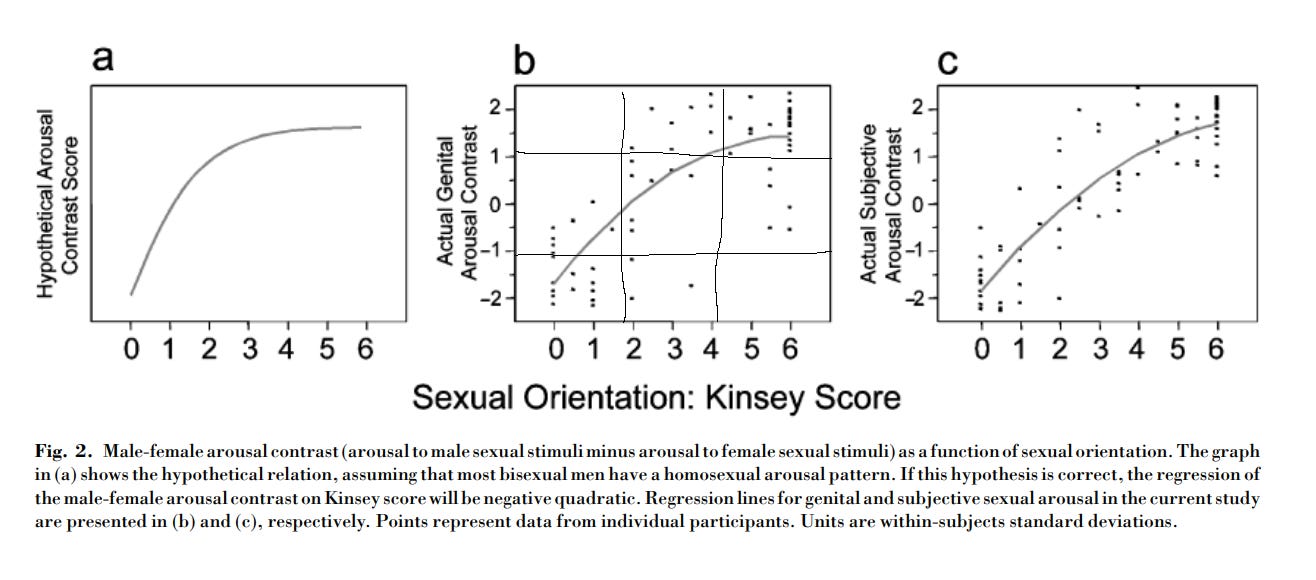
There’s a large discrepancy between self-reported and measured genital arousal: about half of “straight” men are functionally bisexual, half of bisexual men have genital arousal patterns that mimic those of either straight or gay men, and about 25% of gay men have bisexual arousal patterns. There are two ways to intepret this: that people have different ways of interpreting their sexuality (mental vs physical arousal), that they do not accurately report their sexuality, or that people’s reactions to short pornography videos can vary based on temporal factors or content.
Theoretically, if sexual orientation within men were really bimodal, then the attraction people feel towards the sex they are less interested in would be the same regardless of their kinsey score. If it was continuous, then attraction to the less arousing sex would follow a U curve.
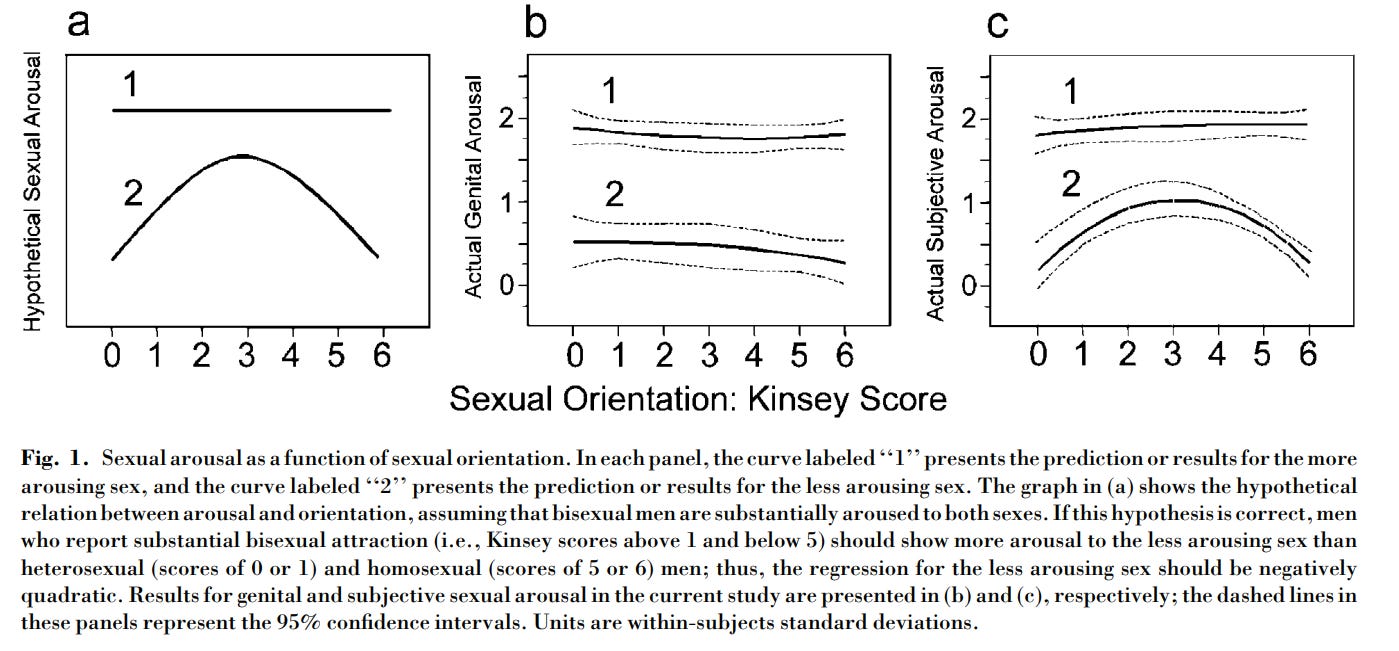
The authors of the study concluded, based on their data, that the bisexuals in their sample were either straight men who reported mental/aesthetic attraction to men, had flexible patterns of sexual behaviour, or were gay men in denial.
One of the authors (JM Bailey) later published a followup paper that tried to empirically test whether bisexuals exist using more participants and a different methodology, and found that male bisexuality does exist:
Jabbour, J., Holmes, L., Sylva, D., Hsu, K. J., Semon, T. L., Rosenthal, A. M., … Bailey, J. M. (2020). Robust evidence for bisexual orientation among men. Proceedings of the National Academy of Sciences, 117(31), 18369–18377. doi:10.1073/pnas.2003631117
The question whether some men have a bisexual orientation— that is, whether they are substantially sexually aroused and attracted to both sexes—has remained controversial among both scientists and laypersons. Skeptics believe that male sexual orientation can only be homosexual or heterosexual, and that bisexual identification reflects nonsexual concerns, such as a desire to deemphasize homosexuality. Although most bisexual-identified men report that they are attracted to both men and women, self-report data cannot refute these claims. Patterns of physiological (genital) arousal to male and female erotic stimuli can provide compelling evidence for male sexual orientation. (In contrast, most women provide similar physiological responses to male and female stimuli.) We investigated whether men who self-report bisexual feelings tend to produce bisexual arousal patterns. Prior studies of this issue have been small, used potentially invalid statistical tests, and produced inconsistent findings. We combined nearly all previously published data (from eight previous studies in the United States, United Kingdom, and Canada), yielding a sample of 474 to 588 men (depending on analysis). All participants were cisgender males. Highly robust results showed that bisexualidentified men’s genital and subjective arousal patterns were more bisexual than were those who identified as exclusively heterosexual or homosexual. These findings support the view that male sexual orientation contains a range, from heterosexuality, to bisexuality, to homosexuality.
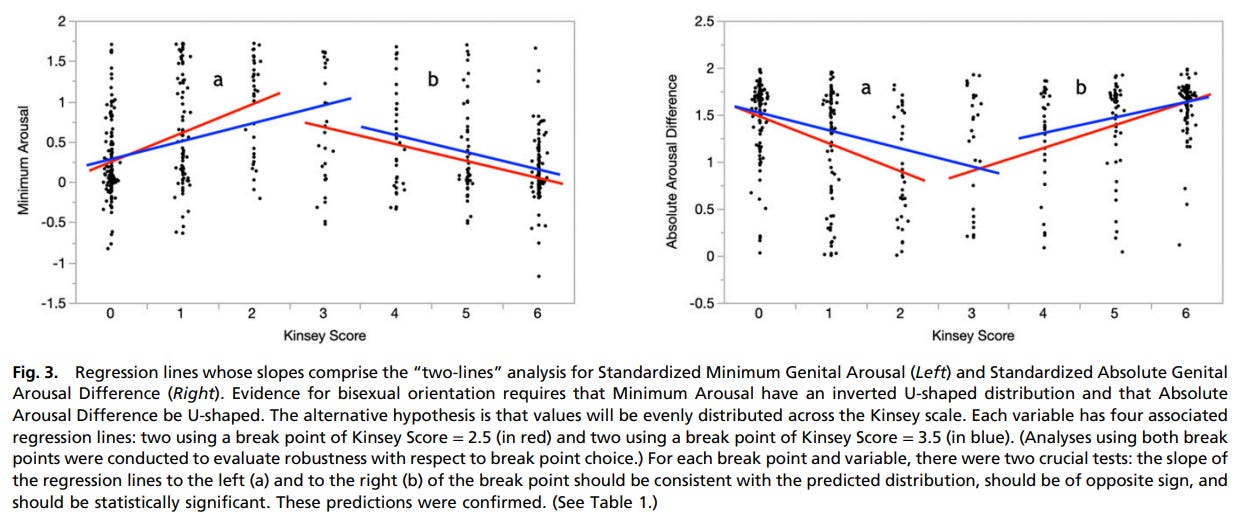
This relationship is also not a function of bisexual men being hornier than regular men, as they also have a smaller difference in their reaction to both sexes:
I must comment: there are a suspiciously large number of straight men with bisexual arousal patterns, which leads me to believe that sexual arousal and self-reported sexual identity don’t correlate highly. Or perhaps, they should not: at the end of the day, sexual identity is just a social signalling mechanism and perhaps it is for the best that there is not a 1 to 1 mapping between arousal and sexual orientation.
Female bisexuality
JM Bailey linked me to a paper he wrote where he argued that sexual orientation was a function of seuxal arousal, and that men tend to be aroused by their preferred sex, while women tended to have bisexual arousal patterns.
One could interpret this as a vindication of the old idea that “all women are bisexual”; JM Bailey instead argues (implies?) that this is an indication that most women do not in fact have a sexual orientation (not necessarily the same as sexual identification), as the function of their libido is not to seek out partners:
I have argued that a man’s sexual orientation is precisely his sexual arousal pattern. If we insist that women have sexual orientations and that sexual orientation must have the same mechanism for both sexes, this leads us to the odd conclusion that most women with heterosexual identities and preferences have a bisexual orientation. (Some lesbians appear to have sexual arousal patterns that match their partner preferences, so I focus on the difficulty of understanding heterosexual women, who comprise the large majority of women.) It would also follow that for heterosexual women, sexual identity and preference have little to do with sexual orientation. This is a logically defensible position, but it is not one that I favor.
An alternative possibility is that laboratory studies have suggested a highly misleading picture of female sexual arousal patterns, which are truly category specific. It would certainly be useful to explore whether other methods (e.g., other kinds of sexual stimuli) might lead to different conclusions. But I do not think it is likely that they will. When I have discussed our findings with women, they have not complained that our results are invalid or misleading, and they have not insisted that they have a sexual arousal pattern that is analogous to that of men. Certainly no one has offered a promising alternative methodology to reveal a category specific sexual arousal pattern in women.
Another alternative is that for most women sexual orientation – the orienting of sexual feelings and behavior toward certain targets and not others – is not about a sexual arousal pattern. In contrast to the male heterosexual arousal pattern, the female heterosexual arousal pattern does not appear to have been designed by evolution to motivate women to seek opposite-sex partners. For most women, their sexual arousal pattern is an ineffective orienting device indeed. One problem with this position is that it requires us to define the same concept, sexual orientation, differently for men and women. A second problem is that if we take this route, we have no good idea what female sexual orientation is. That is, female sexual orientation is a hypothesized mechanism whose existence is unproven and whose nature is unknown. The flip side to this position is that most women may have nothing like a sexual orientation, if sexual orientation is conceived of as a well-designed sexual mechanism that strongly motivates women to select sexual partners of one sex or the other (or both).
If bisexuals exist, then why do they predominantly date one sex (usually the opposite sex)?
Rudder found in Dataclysm that self-described bisexuals often tended to be exclusively interesting in dating one sex, and argued that bisexual patterns of attraction therefore did not exist:
Only a fraction of the bisexual user base has any significant contact with both sexes. Whatever the mechanism, Rieger's claim that self-reported bisexuality doesnt reflect observed behavior appears correct in this case. Interestingly, for men, messaging changes over time. In that change we find plausible evidence for the hedge narrative: more than half of younger bisexual men message only other men, and that percentage drops steadily until the midthirties, at which point most of the male bisexual user base is messaging only women. This is what you would expect to see if men interested in men stop identifying themselves as bisexual as they get older and become more comfortable with being called “gay.’ But this question takes longitudinal data to fully answer, which we dont have yet.
An alternative explanation is that bisexuals differ in their preference for each sex and primarily date that sex. Beyond arousal, some bisexuals may have more positive views of one sex in comparison to the other or have a personality that is more compatiable with dating a particular sex.
It’s not surprising most bisexuals prefer to date the opposite sex, as the incentives to do so are stronger. Sex with the opposite sex can produce children and is more enjoyable, easy to find, and socially acceptable.
Transitional theory
Some theorize that bisexuality serves as a hedge between identifying as straight and gay which some people may be more comfortable coming out of the closet as. There is some longitudinal evidence that suggests this does happen, though its unlikely these make up the majority of bisexuals. There are also many anecdotes of this occuring.
That said, bisexuals are much less likely to be out of the closet than and overwhelmingly date straight people, which is more consistent with them experiencing arousal to the same sex but preferring to date the opposite due to convenience. The fact that there are transitional bisexuals exist also does not invalidate the existence of bisexuality; would the existence of bisexuals who identify as gay for the purpose of avoiding stigma from the gay community invalidate the existence of exclusive homosexuality?


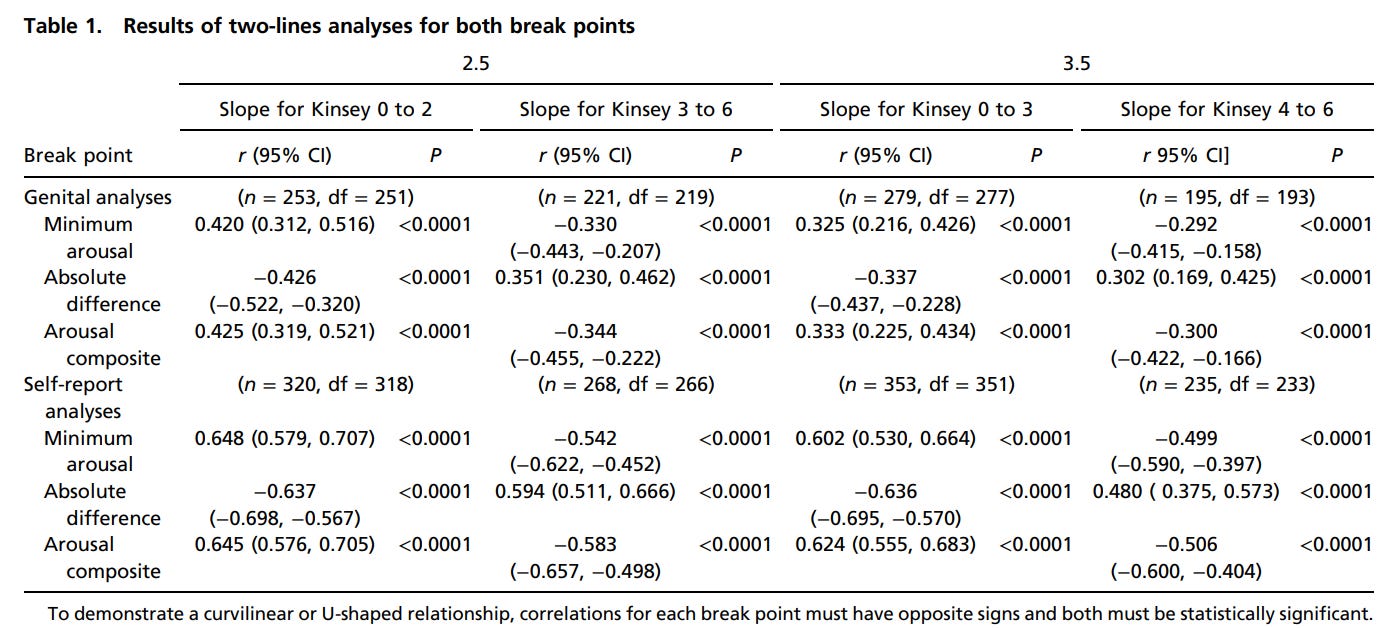
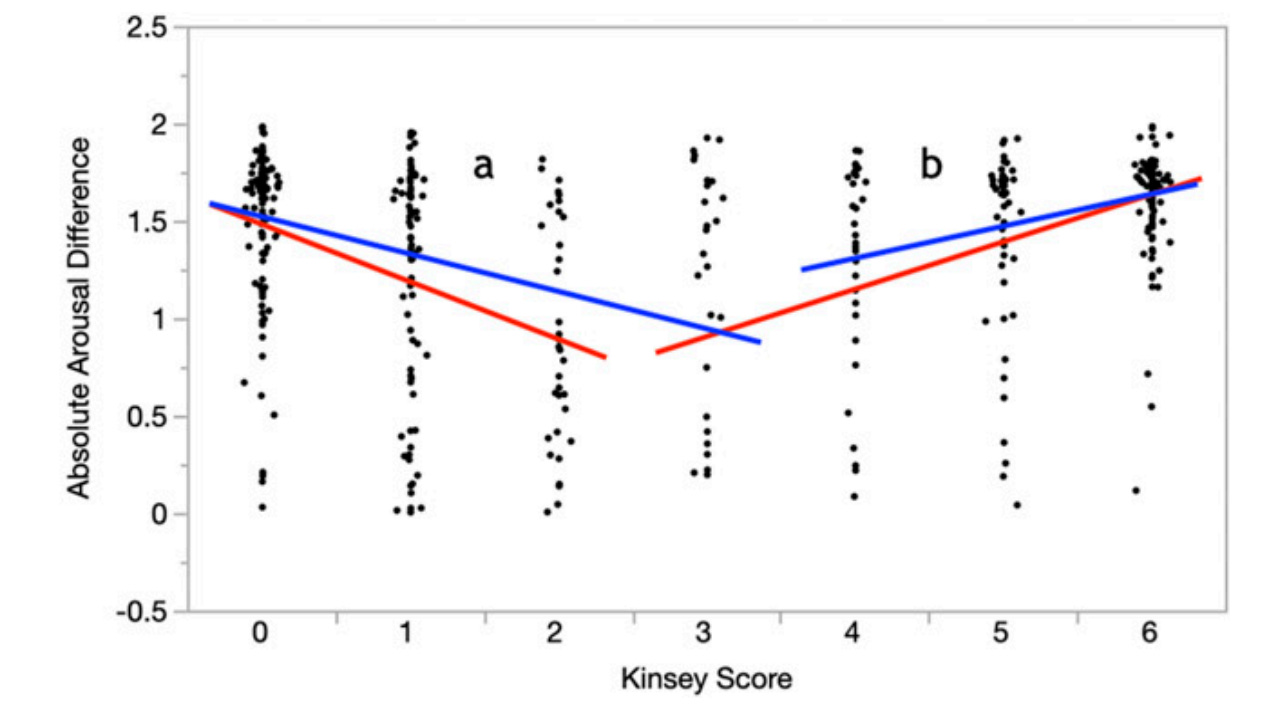
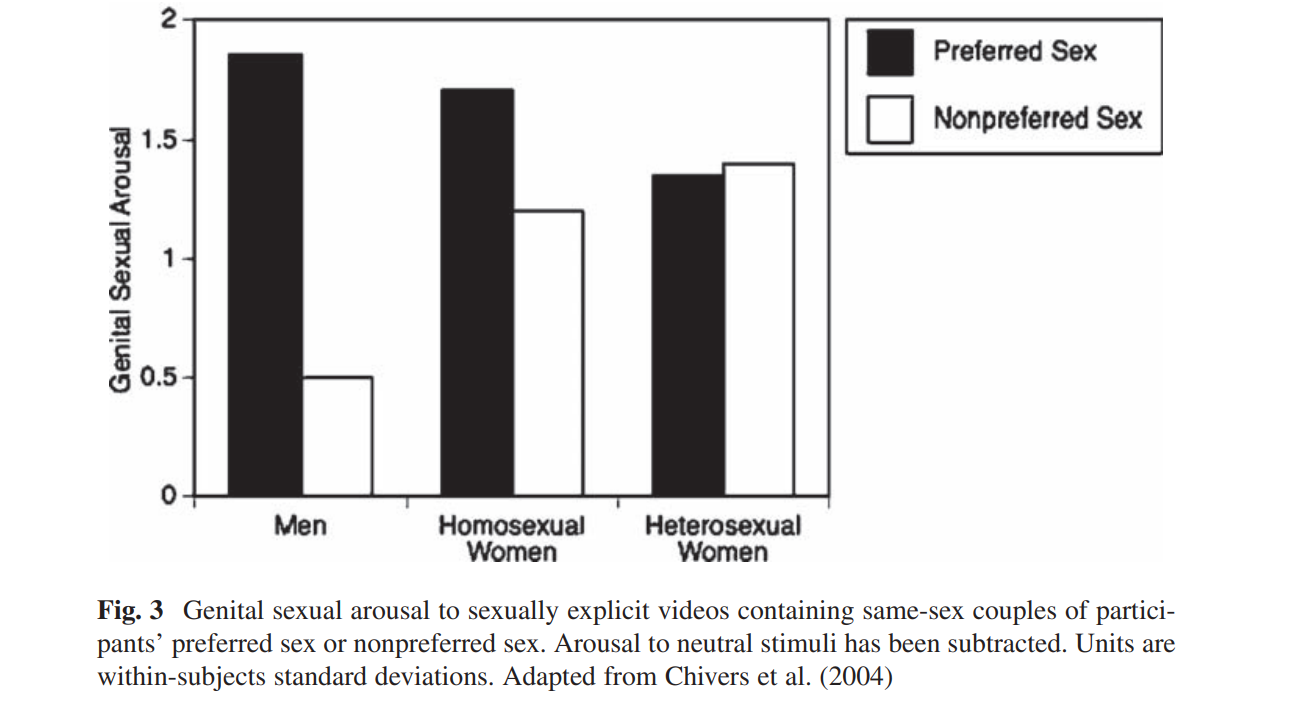
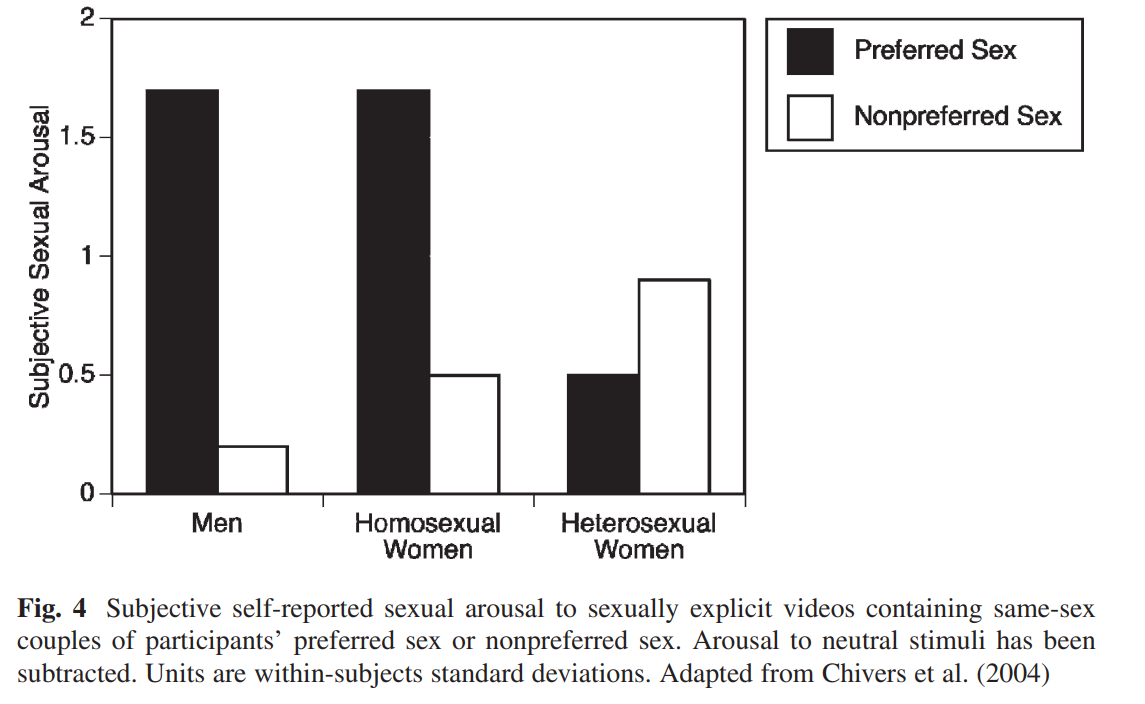
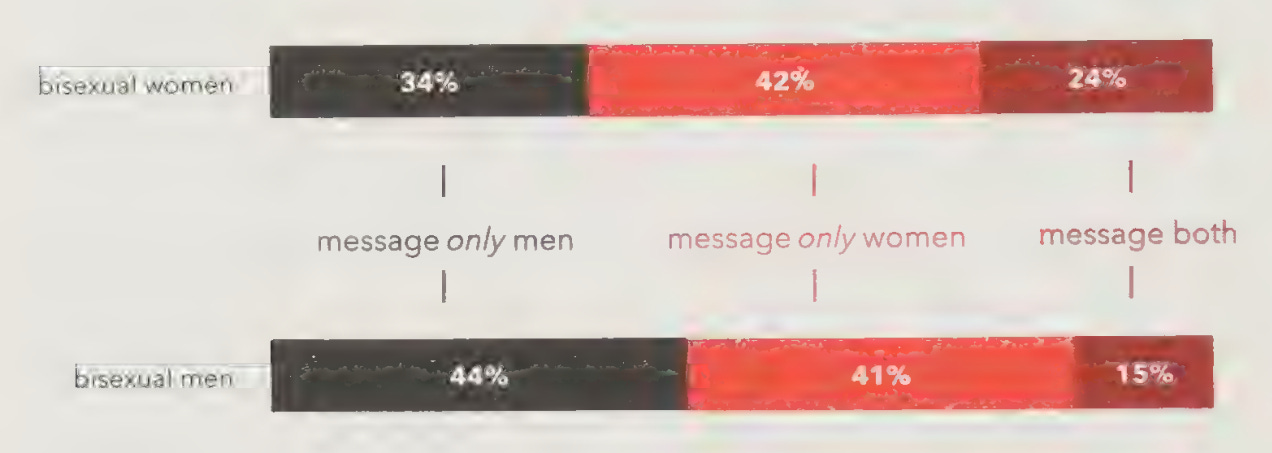
Interesting discussion. I'm a bisexual guy in an open relationship with another man, but I date girls on the side.
Looking at the low percentage of bisexuals messaging both sexes I'd wager that there is a noticeable amount of effort in trying to maintain active courtship with both sexes. I can notice something like this in myself as a bisexual man. There's difference (while still some decent overlap) in the mental frameworks I use when approaching women vs men